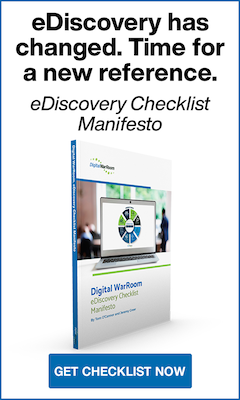In litigation, the producing party is required to provide responsive documents in an agreed-upon format. But you need that information to be accessible for eDiscovery to run smoothly.
What is a Load File
A load file organizes a document corpus and associated metadata so that the production can easily be exported and ingested into a separate e-discovery database. They are the technical instructions that your technologists or your software will use to audit and verify that the production is as-promised and as expected.
These files will be used to incorporate a set of documents, as well as map the corresponding metadata and OCR (optical character recognition), into an e-discovery/document review platform. This load file and the use of correct production specifications should allow the user to search and filter in a fair and equivalent manner to the adversary.
Load Files in eDiscovery
In the eDiscovery process, load files are the bridge between raw data and the review platform, enabling legal teams to efficiently access and analyze case-related documents. These files ensure that the metadata, text, and images are properly categorized, making it easier to search, filter, and retrieve critical information during the litigation process.
 File Types in Production Export
File Types in Production Export
A standard production export usually will include the following file types: DAT, CSV, LFP, and OPT.
Each of these files is considered a load file in its own right, but it's common practice for technologists to utilize a combination of the DAT file—containing metadata and document references—along with either the LFP (Load File Page) or OPT (Optical Character Recognition Path) file upon import. The LFP and OPT files help map the images or scanned documents to the correct metadata and ensure that each page of the document is correctly aligned with its corresponding text and data fields during the review.
This process allows the eDiscovery platform to accurately reconstruct the document set for searching, tagging, and reviewing, ensuring that all files maintain their integrity throughout the production and export phase.
The Components of a Load File
There are two components of a load file: DAT and LFP. Understanding how to access files helps to guide their uses and differences.
DAT or CSV File
DAT is also known as a Concordance load file. So what is it? A DAT file provides metadata information. In this way, a DAT file could be compared to a packing slip or phone book.
This file type is a common, industry-standard way to exchange information of probative value you are obliged to produce and has no burden associated with it. A DAT file also enforces that every document has a unique identifier, usually the bates number.
LFP or OPT File
LFP and OPT ("opticon") files are used to package a production in a standard format. Both file types serve the same purpose but use slightly different formatting. Typically, both will be included in a standard load file folder package.
The OPT/LFP file will help the technologist and eDiscovery tool understand the relationship between documents in a structured manner. Essentially, the LFP/OPT is an audit log that points to the location of the documents.
For example, in the case that documents were produced in single-page images, this LFP/OPT file would be paramount to describe the bates numbers where each document begins and ends. Perhaps bates numbers/pages 0-10 could represent the first document, and 11-15 represent the second document.

Why Are Load Files Important?
Load files provide more information than would be available in a standard PST or raw set of documents. Since PST files do not include a record identifier:
- How do you tell the difference between files produced with the same title or subject?
- Is the original file name available to you?
- From whom did the file come?
This may not be as simple as assigning custodianship to equal the "To" or "From" column. There are many cases in which there could be multiple copies of an email in circulation or many recipients in receipt of the same email. Just because you are on the recipient line doesn’t mean it is your copy of the email. Legal interpretations can be made based on facts not present in the underlying native file.
Depending on the case and the scope of the investigation, certain metadata fields may be probative or irrelevant. This is something to monitor upon sampling the data and performing early case assessment. When assembling protocols and determining relevant fields, make sure to be aware of application and system metadata fields.
File system metadata is required to use the file on a computer. File size, create date, and modified date are examples of fields that could be required by operation on a computer. While these fields may be null or confusing, they are still guaranteed to exist.
Application Metadata
Let's say a word document tracks work by "Jeremy" in the author field. This data only makes sense to Microsoft Word. Not every app needs an author field. Thus this data may need to be exchanged or may not have probative value.
Imagine an example in which your firm hired a technical writer to create a legal document and saved it as a template. Every subsequent document version utilizing this template would contain metadata linking the author to the technical writer. This metadata could be tangential to the facts.
Production of native or image files will be an important cost, budget, and risk consideration. These two types of produced documents will result in folders within a load file that are typically named the following:
- NATIVE - referring to native documents
- IMAGE - referring to image documents
- TEXT/OCR - referring to either 1) extracted text files or 2) OCR associated with the native files or image files
Content Over Media - Negotiating ESI Agreements
The most important thing is to agree on what information is there. The technical format should be fairly standard and considered a part of the duty of technical competence. These obligations must be understood to the extent that both parties can fulfill production obligations in a reasonable manner.
The use of load files and advanced metadata sharing is made possible through an eDiscovery tool and also uses wizards to simplify and support the experience.
With Digital WarRoom (DRW), creating standard format load files is made easy with wizards that walk you through the process and support file loading. Over the last 2 decades, we've incorporated all the features needed to create and ingest standard load files. So while you don’t need to know the underlying technical considerations, you should understand the tools available to you to meet obligations.
Our upcoming Digital WarRoom 10.0 version will also include built-in options to set custom load file delimiters and adjust the naming of each field upon export. Our team is available to support users on load file best practices and help walk through feature upgrades.
Digital WarRoom Optimizes Analysis
DWR early case assessment and review functionality provides important analysis, searching, and filtering tools to encourage data-driven decisions within your ESI negotiation. We believe that the key to what legal professionals need to know about load files is more a conversation about how to ask for the right data.
A standard load file specification document should be kept on hand as a template to ensure that you can easily utilize and view the contents you receive from the opposing party. In 2022, load files are not as complicated anymore and the workflow is not disputed among eDiscovery professionals.
Make sure that you ask for the right deliverables, use the wizards, and clear up time to focus on what really matters - the content and context of the data.
More resources from our video library and user guide are available below regarding topics related to load files.
-1.png?width=400&height=164&name=DWRLogoClassic%20-%20Copy%20(2)-1.png)









Comment On This Article